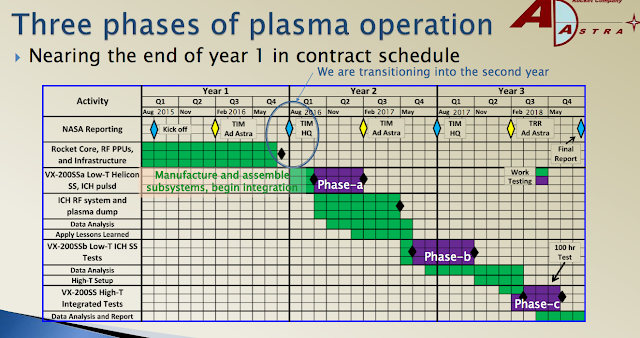Vasimr plasma rocket targeting 100 hours of continuous operation at 100 kW power level early in 2018
by noreply@blogger.com (brian wang) from NextBigFuture.com on (#2DMXZ)
NASA NEXTSTep program awarded Ad Astra Vasimr plasma propulsion a three-year, $9 million contract in 2015. Ad Astra must fire its plasma rocket for 100 hours, at a power level of 100 kilowatts in 2018.
This February, the company has worked about halfway through that contract. Ars Technica reports that the VASIMR engine has been fired at 100kW for 10 seconds and 50kW for one minute.
The goal of this work is to demonstrate a VASIMR(R) engine in thermal steady-state by operating it continuously for 100 hours at a power level of 100 kW
Objectives
a- Achieve the goal over the course of 3 years in 3 phases
a- Phase a: Shake-out basic systems, pulses of minutes, uncooled booster section, accumulate 1 hour, inspect
a- Phase b: Add cooling to booster section, accumulate 100 hours, inspect
a- Phase c: Upgrade rocket core cooling for heat rejection at a 200 C, shake out high temperature cooling systems, install PPUs in vacuum, execute a 100 hour continuous test, inspect
They are successfully hitting plan milestones
Rocket core integration with magnet (Aug 2016)
a- Field line mapping and rocket core alignment
a- Instrumentation and electrical testing
* Integration of VX-200SSa test article in chamber (Sept 2016)
a- Cooling line hookups and leak checking
a- RF matching circuit connections and tuning
a- Command, control and data acquisition verification
* Initial high-power firing with plasma in Phase-a (Oct 2016)
a- Phase-a will have pulse lengths on the order of minutes
a- Measure rocket performance
a- Evaluate aspects of the chamber and plasma dump
* Install final components for VX-200SSb (May 2017)
a- Fully cooled with operation times on the order of hours
* Hot steady-state operation with VX-200SS (Feb 2018)
a- Ready for 100 hours of continuous operation at 100 kW
a- New PPUs installed inside the vacuum chamber







Read more










This February, the company has worked about halfway through that contract. Ars Technica reports that the VASIMR engine has been fired at 100kW for 10 seconds and 50kW for one minute.
The goal of this work is to demonstrate a VASIMR(R) engine in thermal steady-state by operating it continuously for 100 hours at a power level of 100 kW
Objectives
a- Achieve the goal over the course of 3 years in 3 phases
a- Phase a: Shake-out basic systems, pulses of minutes, uncooled booster section, accumulate 1 hour, inspect
a- Phase b: Add cooling to booster section, accumulate 100 hours, inspect
a- Phase c: Upgrade rocket core cooling for heat rejection at a 200 C, shake out high temperature cooling systems, install PPUs in vacuum, execute a 100 hour continuous test, inspect
They are successfully hitting plan milestones
Rocket core integration with magnet (Aug 2016)
a- Field line mapping and rocket core alignment
a- Instrumentation and electrical testing
* Integration of VX-200SSa test article in chamber (Sept 2016)
a- Cooling line hookups and leak checking
a- RF matching circuit connections and tuning
a- Command, control and data acquisition verification
* Initial high-power firing with plasma in Phase-a (Oct 2016)
a- Phase-a will have pulse lengths on the order of minutes
a- Measure rocket performance
a- Evaluate aspects of the chamber and plasma dump
* Install final components for VX-200SSb (May 2017)
a- Fully cooled with operation times on the order of hours
* Hot steady-state operation with VX-200SS (Feb 2018)
a- Ready for 100 hours of continuous operation at 100 kW
a- New PPUs installed inside the vacuum chamber







Read more